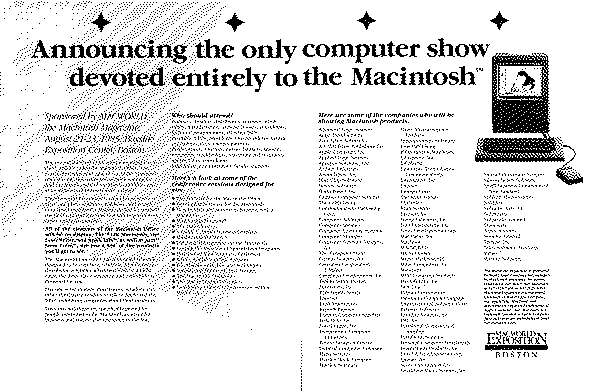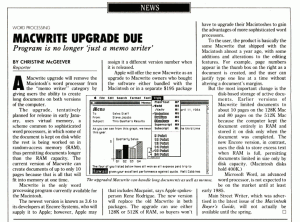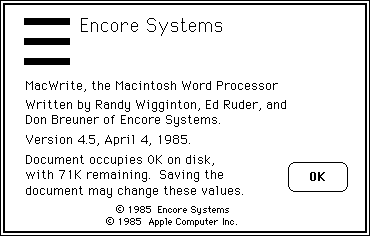MacWorld Expo 1985 Boston
1,133 words
11K on disk
August 1985
 MacWorld Expo 1985 Boston
MacWorld Expo 1985 Boston
Trade Show
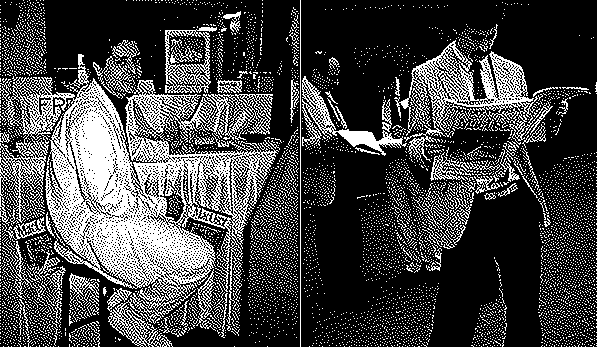
Dates: August 21-23 1987
Cost: $
Attendees: 15,000
Exhibitors: 150
Keynote
Summary
Steve Jobs had just resigned. MacUser‘s Michael Wesley remembers:
The show itself was held… at the convention center in South Boston, in a neighborhood we were told to avoid at all costs. But the glitz and glamour and confusion of a major show took precedence over fear as we prepared for the anticipated arrival of thousands of Mac users (and ran around the floor of thshow scouting all the booths we wanted to visit in depth later.)
There seemed to be a lot of interested and excited people at the show, and many of the companies i talked to were pleased with the turnout. Business software companies were generally visited by people interested in business software, which made them happy. The games, graphics and music people were visited by almost everybody, which meant there was alway a bit of noise and that sometimes made it difficult to sell things like accounting software in neighboring booths.
The Macintosh environment (the one generated outside the machine) is one of the few places where you can still find industry groupies. Everyone I spoke to on the floor had just ended lengthy conversation with Bill Atkinson about improvements they had made to QuickDraw and was he interested, or had just received a glowing commendation for his product from Andy Hertzfeld, or recently bumped into John Sculley. Seems everybody wants to be an insider…
And it seemed that everyone in the industry was looking over everyone else’s shoulder trying to make sure that nobody had a more recent version Switcher or popular public domain utilities than they had. “You mean you don’t have the version __ (insert any two digits separated by decimal)?” And everyone was talking about the new software they had just received to beta test, only to be one-upped by someone saying “Oh, I’ve had that for weeks.”
Wesley’s co-writer Doug Clapp also recalled Hertzfeld’s presence on the show floor:
…Andy Hertzfeld is smiling and chagrined. He really believed in the 128K mMacintosh, he says. He worked as hard as possible to make things small, to make them fit, to make a machine that could run well with only 128K. “And of all the applications for Macintosh,” he says, “the two I did — ThunderScan and Switcher — are the two biggest memory hogs there are1” He shakes his head at the irony.
Seminar Topics
- Macintosh in the Law Office
Apple
Apple pushed new accounting packages (Insight Accounting Series from Layered, Mac Onewrite from Sierra On-Line (!)) as evidence of the platform’s strength in the business market.
The Macintosh, inherently, and the accounting software being written for it, break down the barier that prevents small businesses from buying accountin packages because [they are] too hard.
— Matt Cobb, manager of Apple’s software promotion group, quoted in InfoWorld September 2 1985
Word Processing
Boston Software Publishers intro’d MacIndex, which extended MacWrite to offer subject indexing. It shipped with a DA called Keywords to allow users to mark terms for indexing while in MacWrite.
Desktop Publishing
A fascinating glimpse into what could have been an alternate history of the entire Desktop Publishing market: Microsoft showed off Typographer, a “professional document design and composition system” which it had licensed from creator Broca Software. InfoWorld considered the program so significant it featured a screenshot as the only visual accompanying their coverage of the Expo.
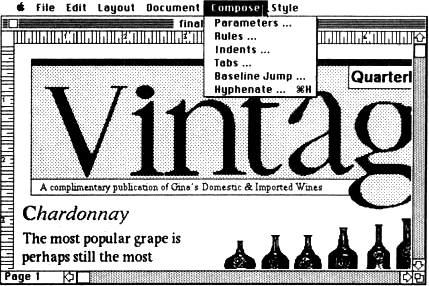
As a signal of how new the concept of DTP was, the accompanying caption explained that the program “lets you incorporate text from word processors and graphics programs such as MacPaint and MacDraw.” Writers in other journals, such as Creative Computing, thought that the app signaled a new era in electronic layout software: “the legitimacy of desktop publishing seems to be proven by the entry of Microsoft into the field with its Typographer program for the Macintosh.”
So what happened? Turns out the program was so buggy that beta testers rebelled, user groups turned up their noses, and Microsoft canceled the entire project. A follow-up article in InfoWorld was titled “Flawed Typographer”, and complained that “The preview copy had enough bugs to keep us from doing much of anything with it; Microsoft has a lot of work left to do before releasing the product — even the program’s name was misspelled on the disk.” An ironic twist to be sure, in a program named Typographer, but there were other problems more serious — users had to switch into and out of layout mode, and screen refresh problems prevented font changes from taking effect.
In comparison to other desktop publishing programs, Typographer was difficult to use. I don’t know who came up with the user interface for this program, but they didn’t do their homework.
— Steve Costa, BMUG, quoted in InfoWorld November 4 1985
By November, three months after the program’s preview at Macworld, Microsoft had announced the software would never ship: it failed to meet their “standards for quality and performance.” Broca, the original developers, said for their part that Typographer “got lost in the middle of a shutdown of Microsoft’s Mac Library publishing effort.” A possible arrangement with T/Maker as publisher apparently never came to fruition, and for all intents and purposes this software has been lost to time.
So much for Broca Software. But what of Microsoft itself? By 1986 the company was “admitting it has missed its opportunity to produce independent desktop publishing programs,” according to an article in InfoWorld. Who knows how the competitive landscape might have looked for Aldus PageMaker and Quark XPress if Typographer had been a hit?
Speaking of forgotten software, Boston Software Publishers (mentioned above) also showed off MacPublisher II, which should probably be filed into the category “DTP programs which shipped before Aldus PageMaker.” Interestingly enough, Wikipedia claims MacPublisher was the first DTP program for the Mac. The whole article there is worth a read — it’s well-sourced and includes tidbits such as MacPublisher being the first to support color printing on the ImageWriter II.
Spreadsheets
Graphics
Productivity
Utilities
Early macro program MacTracks made its debut for $30 from publisher Assimilation Inc, which also introduced a $40 print spooler called Work ‘n Print.
Peripherals
General Computer brought out the new Hyperdrive 20 for $2,800 — upgrade for only $900! Other expansion products included Beck-Teck’s clip-on Macmegabytes 1MB RAM board, available for both the 128 and 512.
NEC Colormate was a hardware/software combo to allow eight-color printing on the NEC Color Pinwriter dot-matrix printer.
Assimilation Inc showed off a $50 combo trackball/numeric keyboard called Numeric Turbo, which instantly transformed the humble Mac keyboard into a battleship-sized behemoth:

